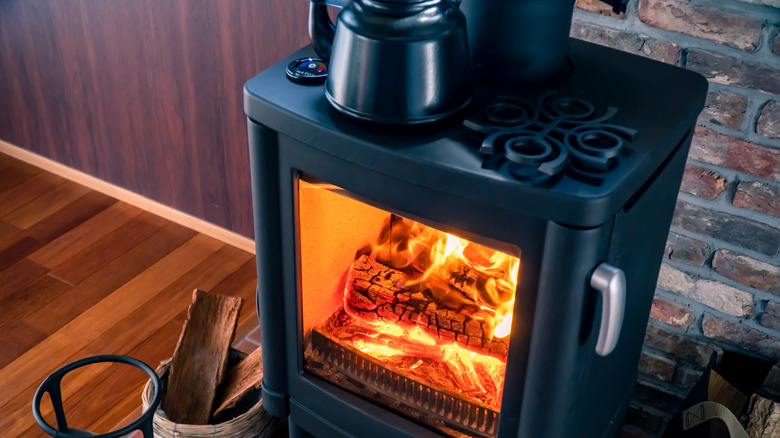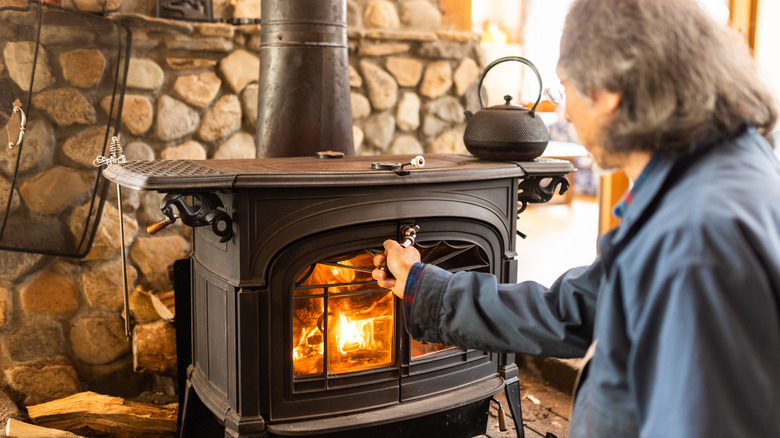Why The Future Of Wood Burning Stoves In Homes Is Uncertain
There is certainly something nostalgic, earthy, and fascinating about using a wood-burning stove in your home. The sound of the crackling wood, the smell of the fire, and the ability to control your home's heating with a log or two make these stoves an attractive option to many. However, some states believe these stoves are causing too much pollution, and they're taking legal action to get some of them banned.
The attorney generals from 10 states have filed a lawsuit against the U.S. Environmental Protection Agency (EPA) with the goal of making it harder for homeowners to purchase and use stoves that they believe are contributing excessively to pollution. Specifically, they believe that the programs the EPA put into place do not actually benefit pollution control as promised, and they want changes to be made.
Are wood-burning stoves a problem? According to the American Lung Association, they are a significant contributing factor to particle pollution in the air, and they create the added risk of carbon monoxide, a dangerous gas that can build up in homes and cause illness or death. They also may contribute carcinogens to the air. More so, they note that using wood-burning stoves increases the amount of carbon dioxide and methane released into the planet's air, which contributes to pollution and could be a factor in climate change.
Why these states are fighting the EPA
THE EPA has a number of programs in place to incentivize the use of cleaner burning and environmentally friendly appliances and heating and cooling systems in homes. These clean energy programs are meant to encourage people to use more efficient, less pollution-causing solutions in their homes and often offer monetary compensation for those who make the switch.
The attorney generals in the states of Alaska, Illinois, Maryland, Massachusetts, Minnesota, New Jersey, New York, Oregon, Vermont, and Washington believe that though these cleaner energy programs promise to encourage improvements when people switch out wood-burning appliances, have not helped to improve air pollution in their areas. The problem, they say, is that the products being switched out aren't any cleaner and therefore don't offer any benefits. These states want improved programs that involve more testing and even certification programs to ensure that such systems are actually worth the investment and create environmental change in the country.
The move is valid in that in 2015, the EPA's own offices reported that the strategies they were using to test residential wood-burning heaters were not accurate or reflective of real-world situations. That makes those tests invalid and the promise of improved energy nonexistent. That means that the $82 million in grants that are used to help fund these EPA clean energy programs may not be doing what they were intended to do in creating improved clean air for Americans. The EPA hasn't officially commented on any actions it plans to take.
Determining if your wood-burning stove is safe
For residents who have a wood-burning stove in their home, especially those who hoped to see an improvement in their air quality after switching out an older version for a newer model, it may be time to take a closer look at your appliance. There are steps you can take to reduce the risk to health and the environment if you have a wood-burning stove or other appliance in the home that you use. For example, choose an EPA-certified wood-burning stove, but also go a bit further. Learn what the standards are for your product from the manufacturer. Compare these appliances carefully to each other to find those that offer proof of their ability to reduce emissions when used in the home. The American Lung Association does not recommend the use of wood-burning emissions inside a home unless it is the only source of heat available.
It's also important to properly vent these appliances, ensure the fireplace and woodstoves are maintained properly with the help of professionals, and run an air purifier to help further improve air quality in your home. If you're not sure if the air quality in your home is safe, consider an at-home or professionally conducted indoor air quality inspection. This will allow for testing of the quality of air present with and without the use of your wood-burning stove. It can give you insight into whether continued use of your stove is advisable.


